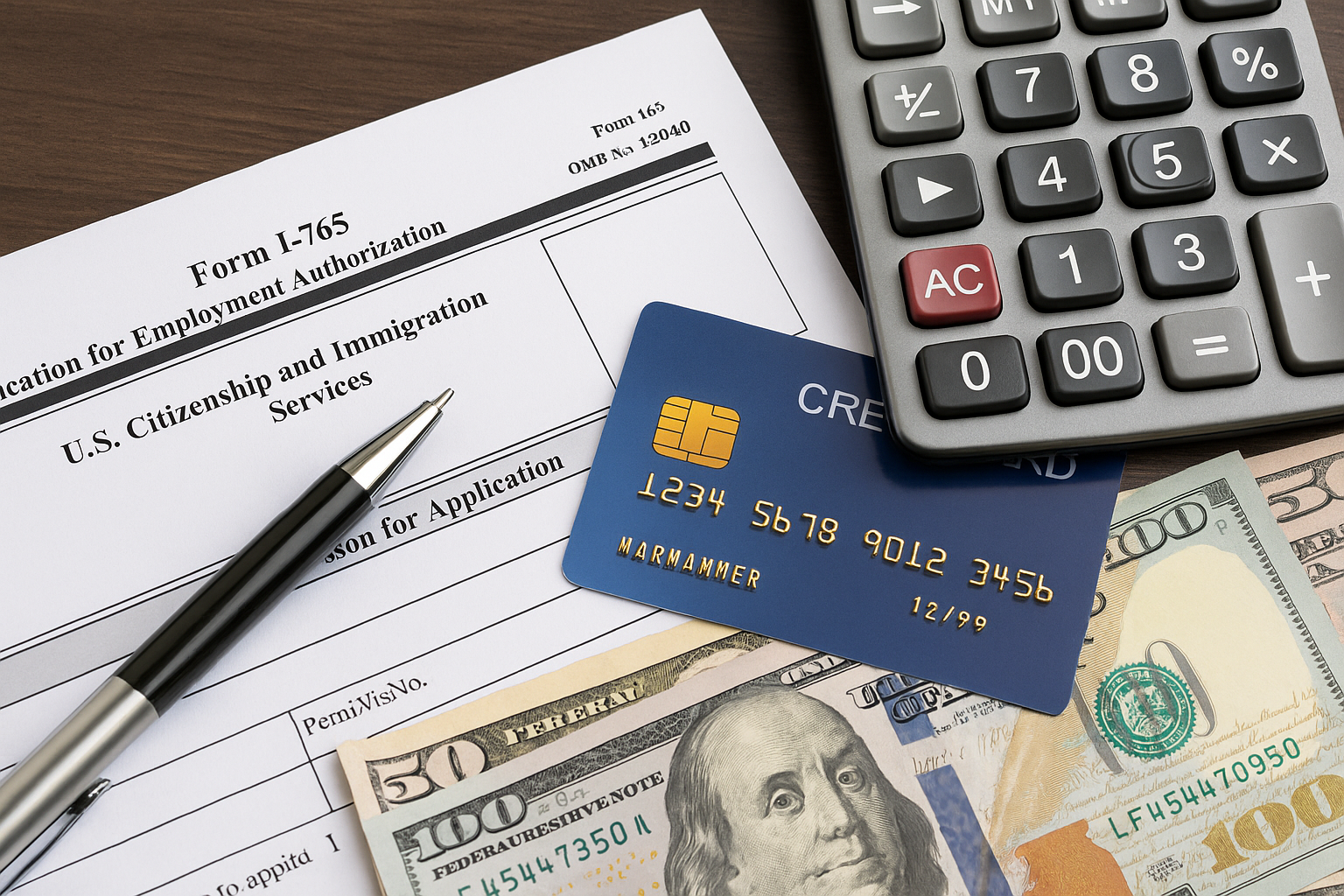USCIS has announced a major change to how filing fees must be paid for paper-filed immigration applications — a shift that affects thousands of applicants, employers, and attorneys nationwide. Beginning October 28, 2025, USCIS will no longer accept paper checks or money orders for paper filings. Instead, applicants must use approved electronic payment methods only, specifically credit card (Form G-1450) or ACH debit from a U.S. bank account (Form G-1650).
This update is part of USCIS’s broader modernization effort to streamline payment systems, reduce fraud, and improve processing efficiency. For applicants, this change is significant and demands immediate preparation.
In this comprehensive guide, Orange Law Firm walks you through everything you need to know, including a step-by-step guide, a compliance checklist, consequences of incorrect payment, expert insights, comparisons, FAQs, and more.
How to Comply With the New USCIS Payment Rules
Step 1: Determine Your Filing Type
If you are filing online, you may continue using the USCIS online payment portal.
If you are filing by mail, you must follow the new electronic payment rules.
Step 2: Choose the Correct Payment Method
USCIS allows only two payment methods for paper filings:
- Credit or debit card via Form G-1450
- ACH debit from a U.S. bank via Form G-1650
Paper checks and money orders are completely discontinued unless a rare exemption applies.
Step 3: Complete the Payment Authorization Form
- Form G-1450: For U.S.-issued credit or debit cards. Must be signed.
- Form G-1650: For ACH debit. Requires a valid U.S. bank account with no debit blocks.
Place the form on top of the paper filing packet.
Step 4: Verify Bank or Card Readiness
- Ensure funds are available
- Remove ACH debit blocks
- Confirm routing/account numbers
- Use a U.S.-issued credit/debit card only
Step 5: Keep Digital and Physical Records
Save:
- A photocopy of the payment form
- Bank or card statement
- Entire filing packet
This protects you in case USCIS disputes payment.
Step 6: If You Don’t Have a U.S. Bank Account
You may still use:
- A U.S.-issued prepaid card
- A U.S.-issued credit card
- Assistance from an employer or authorized representative
Pre-Filing Payment Compliance
- Before mailing your application, make sure you have:
- Determined whether your filing is paper or online
- Selected Form G-1450 or Form G-1650
- Verified bank/card funds
- Removed ACH debit blocks
- Entered the correct filing fee
- Signed the payment form
- Avoided including checks or money orders
- Kept copies of all documents
This checklist helps prevent the most common reasons for rejection under the new rules.
What if pick Incorrect Payment Type
Using the old payment method — such as a check or money order — after October 28, 2025, has serious consequences:
Rejection of Your Filing
USCIS will return your entire application without processing.
Delay in Case Processing
A rejected application can push timelines by weeks or months.
Non-Refundable Fees
Once payment is processed electronically, it is generally non-refundable.
Possible Status Issues
A rejected application could lead to:
- Missed deadlines
- Lapsed immigration status
- Interrupted work authorization
For Employers
Improper payments can impact employees’ visas and work continuity.
Our Opinion
At Orange Law Firm, we consider this policy change a positive modernization step. The old system relying on checks and money orders led to:
- Lost payments
- Returned mail
- Slow processing
- Fraud risks
However, this new policy requires applicants to be far more diligent. A simple error — such as insufficient funds or an ACH block — can lead to immediate rejection.
Our recommendation:
- Prepare early
- Double-check financial details
- Seek legal guidance if unsure
- Employers should immediately update HR workflows
This transition, if handled properly, can make the immigration process faster, safer, and more efficient.
Old vs New Payment System
| Aspect | Before Oct 28, 2025 | After Oct 28, 2025 |
| Payment methods accepted | Credit card, check, money order | Credit card or ACH only |
| Checks & money orders | Allowed | Completely discontinued |
| Risk of lost payments | High | Very low |
| Processing speed | Slower | Faster electronic processing |
| ACH debit | Optional | Primary option |
| Foreign applicants without U.S. bank account | Could use checks/money orders | Must use U.S.-issued credit card |
| Government efficiency | Slower, manual sorting | Automated digital processing |
This comparison shows a clear shift toward a fully digital payment ecosystem.
Simplified for Readers
Form G-1650 – ACH Debit Authorization
- Used to debit a U.S. bank account
- Account must allow third-party ACH debits
- Incorrect routing numbers will cause rejection
- Requires available funds at time of processing
Form G-1450 – Credit Card Authorization
- Accepts U.S.-issued credit or debit cards
- Form must be signed
- USCIS destroys the form after processing
Key Technical Notes
- USCIS may attempt ACH withdrawal only twice
- Declined or returned payments result in rejected filings
- Fee amounts must exactly match the USCIS Fee Schedule
- USCIS’s updated Policy Manual (PA-2025-19) governs these rules
FAQs
Q1: Does this change affect every USCIS form?
Only paper-filed applications. Online filings follow online payment rules.
Q2: Can I still use a check if it is a cashier’s check?
No. All paper checks and money orders are discontinued.
Q3: I am filing from abroad. I don’t have a U.S. bank account.
Use Form G-1450 with a U.S.-issued card or prepaid card.
Q4: What happens if the ACH payment fails?
USCIS may reject your entire application.
Q5: Are fees refundable?
No. USCIS fees are non-refundable unless the agency makes an error.
Impact on Applicants & Employers
USCIS processes millions of fees annually, most historically through paper checks. According to policy updates, paper payments contributed to:
- Lost mail
- Fraud attempts
- Slower case intake
- Higher administrative costs
This new rule supports the federal initiative under Executive Order 14247, pushing all government agencies toward electronic payment systems.
Benefits of the New Policy
- Faster confirmation of payment
- Lower fraud risk
- Reduced USCIS workload
- Better tracking for applicants
- Eliminates delays caused by bad checks
Challenges
- Applicants without U.S. banking access must shift to prepaid cards
- ACH blocks and insufficient funds create new rejection risks
- Employers must retrain staff who process immigration payments
Overall, the shift is beneficial — but only if applicants adapt quickly and carefully.
Legal & Financial Terms Explained
ACH (Automated Clearing House)
A secure U.S. system for electronic bank transfers.
ACH Debit Block
A restriction on a bank account that prevents companies from withdrawing funds.
Form G-1450
Authorizes USCIS to charge a U.S.-issued credit/debit card.
Form G-1650
Authorizes USCIS to debit a U.S. bank account.
Paper-Filed Benefit Request
Any immigration application submitted by physical mail.
Fee Schedule
USCIS’s official list of filing fees.
Policy Manual Update (PA-2025-19)
The official USCIS publication explaining the new electronic payment rules.
Conclusion
The October 2025 USCIS payment update marks one of the most important procedural changes in recent years. By eliminating checks and money orders and shifting fully to digital payments, USCIS aims to improve security, reduce delays, and modernize its systems.
For applicants, however, this means careful preparation is absolutely essential. Using the wrong payment method can lead to immediate rejection — even if everything else in your application is correct.
At Orange Law Firm, we are committed to helping clients adapt to these new rules smoothly and confidently. If you need assistance preparing Form G-1650, verifying payment readiness, or reviewing your entire application packet, our team is here to guide you.
Attorney Karan Joshi
Houston immigration lawyer
Award: Best of the Best Winner 2025



